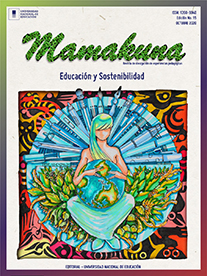School project of urban art as a strategy for the sustainability of the Amazonian kichwa culture applied in eighth year students of the UECIB "Amauta Ñanpi
DOI:
https://doi.org/10.70141/mamakuna.15.418Keywords:
Arte urbano, proyecto escolar, Estrategias Didácticas Artísticas, Cultura Kichwa Amazónica, Educación Intercultural BilingüeAbstract
The work analyzes, explores and collects conceptual data and artistic and cultural urban elements, for the design and application of didactic strategies for the sustainability and strengthening of the Amazonian Kichwa language and culture, through a school art project that has been implemented in the eighth grade of the Intercultural Bilingual Community Education Unit (UECIB) "Amauta Ñanpi". This school art project was structured in five methodological processes: diagnosis, socialization, implementation, development and reflection, which allowed the project to be developed and to obtain timely information regarding the identification, recognition, valuation, strengthening and consolidation of the artistic and cultural practices present in the school context.
Downloads
References
Acaso, M. (septiembre de 2017). Del Design Thinking al Art Thinking: Cómo transformar la educación a través de las artes. En Gobierno de Aragón (Presidencia), I Congreso Internacional Innovación Educación. Conferencia llevada a cabo en el congreso de Gobierno de Aragón, Zaragoza, España.
Albán, A. (2013). Capítulo 13: Pedagogías de la re-existencia. Artistas indígenas y afrocolombianos. En C. Walsh. (Ed.), Pedagogías decoloniales. Prácticas insurgentes de resistir, (re)existir y (re)vivir. Tomo I. (443-468). Quito, Ecuador: Abya Yala.
Castro, E. (2004). El vocabulario de Michel Foucault: un recorrido alfabético por sus temas, conceptos y autores. Bernal, Argentina: Universidad Nacional de Quilmes.
Consejo Nacional de la Cultura y las Artes. (2016). Porqué enseñar Artes y cómo hacerlo. Santiago de Chile, Chile: Ograma Impresiones.
Del Río, P. (2004). “El arte es a la vida lo que el vino es a la uva”. La aproximación sociocultural a la educación artística. Cultura y Educación, 16(1-2), 43-64.
Fals Borda, O. (1999). Orígenes universales y retos actuales de la IAP. Análisis Político, (38), 73-90.
Feixa, C. (1999). De jóvenes, bandas y tribus: Antropología de la Juventud. Barcelona, España: Ariel S.A
KRS One. (1980). El góspel del Hip Hop: primer instrumento presentado para el templo del Hip Hop. New York, EEUU: I am Hip Hop.
Ledesma, O. (1995). El pasado en el presente de Puyo: I parte. Puyo, Ecuador: Ilustre Municipio de Pastaza.
Lowenfeld. V. y Brittain, L. (2008). Desarrollo de la capacidad intelectual y creativa. Madrid, España: Editorial Síntesis.
MINEDUC. (2016). Educación Intercultural y Artística: Currículo de EGB y BGU. Quito. Recuperado de https://educacion.gob.ec/wp-content/uploads/downloads/2016/03/ECA_COMPLETO.pdf
MINEDUC. (2017). Ishkay Shimi Kawsaypura Kichwa Mamallaktayukkunapa Yachayñan. Quito, Ecuador: Ministerio de Educación del Ecuador.
MINEDUC. (2018). Proyectos Escolares: Actualización del Instructivo de Proyectos Escolares. Quito, Ecuador: Ministerio de Educación del Ecuador.
Schensul, S., Schensul, J. y LeCompte, M. (1999). Essential ethnographic methods: Observations, interviews, and questionnaires. Walnut Creek, California: AltaMira Press.
Walsh, C. (2005). La interculturalidad en la Educación. Lima, Perú: Ministerio de Educación y UNICEF.
Published
How to Cite
Issue
Section
License
Copyright (c) 2020 Mamakuna

This work is licensed under a Creative Commons Attribution-NonCommercial-ShareAlike 4.0 International License.





